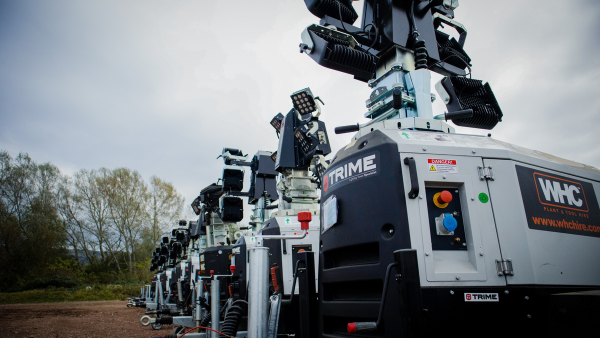Select The Right Tower Lighting In 5 Easy Steps
Tower lighting has been an essential component of safe and productive work after dark. They provide adequate illumination for workers and the public on building sites, roadsides and for other various activities. Generally, they are operated all year round, but most popular during the Autumn/Winter months to extend working hours in the construction and emergency services sector. In today’s article, we will be discussing how to select the right tower lighting for your project, factors you may need to consider, and what the cost could be.
How does tower lighting work?
Tower lighting is powered by a petrol or diesel engine, designed to provide reliable and consistent lighting for the users. The machine consists of a generator engine, mast, lifting system, and electric lamps. Designs vary in size, power output, bulb type and height. Therefore, choosing the correct tower lighting for your project is important to provide a safe working environment for your staff. Having inadequate lighting could lead to injury or delays in your project’s completion. Some examples of where tower lighting is used are:
- Construction sites
- Roadside work
- Mining or underground works
- Nighttime work
- Airports
- Events and festivals
- Emergency electrical work
- Emergency Rescue
- Sports grounds or races
- Hospitality
- Performing trade out of hours tasks in poorly lit areas
Factors to consider when choosing the right tower lighting?
Coverage and brightness
Probably the most asked question about tower lighting is, how much coverage will you get from a tower light? Each machine’s output will differ, however, expect to cover anything from 2,000-8,000 square meters of lighting from a single machine. Along with coverage, another factor you need to be aware of is the level of illumination that you require.
Illumination is measured in lumens, with one lumen being as bright as a single candle, compared to a standard 80w lightbulb producing around 800 lumens. Tower lighting typically creates between 110-120 lumens per watt produced by its generator. Therefore, you should expect to produce anything between 75,000 and 250,000 lumens across the total number of lamps.
Another element you may come across in your search for the right tower light is ‘lux level’. Lux is a different type of light measurement which, unlike lumens (a measurement taken directly from the lamps), lux measurements refer to the amount of light reaching the ground. The higher the tower light is, the larger output you will need to achieve sufficient illumination for your project. You should expect a level of between 10-20 lux as standard from a lighting tower.
Transport and mobility
When assessing the size of tower lighting you require, you will need to consider the portability of the machine itself. Some towers are designed specifically for a single person to manoeuvre, whereas others may require machinery. For use in an event or emergency service response, a towable tower light would be more desirable than a wheelbarrow style machine due to its portability. Multiple tower lights can be a logistical nightmare, therefore, it is worth discussing your requirements with a professional hire service to have them delivered to site for you if you are unable to do so. Machines can differ from 300kg to 1 ton in weight depending on type and power size.
Fuel efficiency
Be sure to consider the time that the machine will be in use. You should be able to get a minimum of 24hrs continuous operations from one tank of fuel, however, tower light fuel capacities, size and economy all will affect fuel efficiency. You may find that some tower lights are fitted with LED lamps that produce similar levels of lumens for a smaller wattage. This, in turn, has a positive effect on your overall fuel usage for the duration of your hire.
Automation features
Do you require your tower light to be automated? For use on building sites, events or even airports where lights are positioned in one place for a long period, this feature can be a benefit in saving time and man-hours. Especially if you have several machines within the area you are working. Automation features allow you to control when tower lights operate without having to be present to start them yourself.
Noise level
When it comes to running any type of generator, one factor you will want to be mindful of is the noise pollution it will create. If you are planning to undertake work during the night then a tower light with a silent engine is best suited, particularly in urban areas. In addition, you must be cautious of a safe operating distance from larger tower lights that produce in excess of 85db. Workers exposed to these higher levels of noise should be provided with adequate PPE.
How much does the right tower lighting cost to hire?
Tower lights range in price because of their functionality, size and power. These factors have impacted the cost of hire per week. You should expect to pay between £180-375.00 +VAT per week for a 9m towable tower light. However, it is best to check directly with your supplier first, especially if you are budgeting for a long-term project. (Prices are based on an online survey conducted in October 2021)
We at WHC Hire have been supplying the construction, events and emergency sector with the highest quality tower lighting for over 20 years. With continuous investment into the quality of our equipment, we can assure that customers, contractors and businesses (no matter their size) receive their required equipment on time and in perfect working condition. With depots in Tewkesbury, Worcester and the Cotswolds that service the whole of the UK, we are available on hand when you need us.
If you would like to find out more about what tower lighting solutions we have to offer, click here, or call 01684 377977 today.

